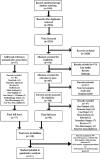Spinal accessory nerve transfer for shoulder abduction has no benefit over supraclavicular exploration and nerve grafting in brachial plexus birth injury: a systematic review
- PMID: 39748811
- PMCID: PMC11693444
- DOI: 10.3389/fped.2024.1426105
Spinal accessory nerve transfer for shoulder abduction has no benefit over supraclavicular exploration and nerve grafting in brachial plexus birth injury: a systematic review
Abstract
Introduction: Brachial plexus birth injury (BPBI) has an incidence of 0.9 per 1,000 live births in the population. Techniques for repair classically include supraclavicular exploration and nerve grafting (SENG) and more recently nerve transfer, namely of the spinal accessory nerve (SAN) to the suprascapular nerve (SSN) to improve functional outcomes such as glenohumeral abduction and external rotation. This systematic review was conducted to evaluate whether spinal accessory nerve transfer produced significantly better outcomes for shoulder abduction in BPBI.
Methods: A search was conducted using Preferred Reporting Items for Systematic Reviews and Meta-Analysis Individual Patient Data guidelines. Standardized comparisons were made using the Mallet Score for shoulder abduction.
Results: 10 full-text articles with itemized patient outcome measures were selected. 110 patients were identified with 51 patients in the SENG group and 59 patients in the SAN transfer group. The mean shoulder abduction Mallet score in the SENG group was 3.50 ± 0.84, while the mean Mallet score in the SAN transfer group was 3.58 ± 0.77, which displayed no significant differences (p = 0.9012). There was no significant relationship between the age at time of surgery and post-operative Mallet scores for shoulder abduction after SENG (p = 0.3720).
Discussion: Our systematic review found that there was no difference observed in post-operative outcomes of shoulder abduction when comparing SAN transfer and nerve grafting. Continued support for nerve grafting lies in the argument that it incorporates the patient's native neuroanatomy and allows for sensory reinnervation.
Keywords: brachial plexus birth injury; nerve graft; nerve transfer; outcome; peripheral nerve; surgery.
© 2024 Mendiratta, Singh, Abdelmalek, Pant, Chu and McGrath.
Conflict of interest statement
The authors declare that the research was conducted in the absence of any commercial or financial relationships that could be construed as a potential conflict of interest.
Figures
Similar articles
-
The extent of brachial plexus injury: an important factor in spinal accessory nerve to suprascapular nerve transfer outcomes.Br J Neurosurg. 2020 Oct;34(5):591-594. doi: 10.1080/02688697.2019.1639620. Epub 2019 Jul 15. Br J Neurosurg. 2020. PMID: 31307250
-
Outcomes of Spinal Accessory-to-Suprascapular Nerve Transfers for Brachial Plexus Birth Injury.J Hand Surg Am. 2019 Jul;44(7):578-587. doi: 10.1016/j.jhsa.2019.02.004. Epub 2019 Mar 18. J Hand Surg Am. 2019. PMID: 30898464
-
Combined Radial to Axillary and Spinal Accessory Nerve (SAN) to Suprascapular Nerve (SSN) Transfers May Confer Superior Shoulder Abduction Compared with Single SA to SSN Transfer.World Neurosurg. 2019 Jun;126:e1251-e1256. doi: 10.1016/j.wneu.2019.03.075. Epub 2019 Mar 18. World Neurosurg. 2019. PMID: 30898759
-
Results of spinal accessory to suprascapular nerve transfer in 110 patients with complete palsy of the brachial plexus.J Neurosurg Spine. 2016 Jun;24(6):990-5. doi: 10.3171/2015.8.SPINE15434. Epub 2016 Feb 12. J Neurosurg Spine. 2016. PMID: 26871649
-
Intercostal Nerve Transfer for Biceps Reinnervation in Obstetrical Brachial Plexus Palsy: A Preferred Reporting Items for Systematic Reviews and Meta-Analysis for Individual Patient Data Systematic Review using Individualized Fusion and Comparison to Supraclavicular Exploration and Nerve Grafting.J Child Orthop. 2023 Dec 4;18(1):54-63. doi: 10.1177/18632521231211644. eCollection 2024 Feb. J Child Orthop. 2023. PMID: 38348437 Free PMC article. Review.
References
Publication types
LinkOut - more resources
Full Text Sources



